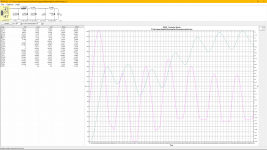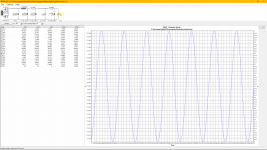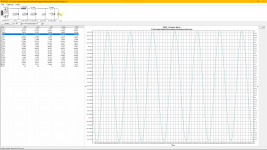Digikey dropped off the other half of my order. I'm impressed by the individual packaging and labels.
I thought I was done with ordering, but I was going through everything and I realized I order the wrong size headphone jack. Now I have a 1/4 12b switchcraft jack and isolating bushings that I'll never use. Finding an isolated 3.5mm jack has turned up squat besides Amazon cheapies.
Twin terminal strips for the bias control sections. (Space is an issue I might have to go point to point) The keystone lugs ( size 6 and 8)will be my chassis (input jack) ground tpoint and the eyelets will go in the psu fr4 board.
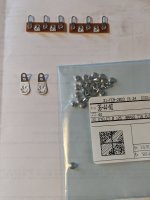
Eyelet tools can be pricey and usually require a drill press. I searched for awhile and came up with a Michael's craft store 1/8th punch. (Hope it works)

 The red board is going to eat some real estate. I might use all 4 caps or drop down to 3 to save some space. The rectifier choice will be 🔐
The red board is going to eat some real estate. I might use all 4 caps or drop down to 3 to save some space. The rectifier choice will be 🔐
(That big no name film cap came from a inductively coupled plasma mass spec that I was lucky enough to rip apart)
Originally I selected axial caps for a wishful thinking turret board design. That idea was quickly dropped in favor of a large terminal strip. I like the 100uf f and t caps for the bias, unfortunately they're probably too large. (Seems to be a theme of mine. Order before measuring)
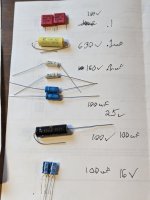

I thought I was done with ordering, but I was going through everything and I realized I order the wrong size headphone jack. Now I have a 1/4 12b switchcraft jack and isolating bushings that I'll never use. Finding an isolated 3.5mm jack has turned up squat besides Amazon cheapies.
Twin terminal strips for the bias control sections. (Space is an issue I might have to go point to point) The keystone lugs ( size 6 and 8)will be my chassis (input jack) ground tpoint and the eyelets will go in the psu fr4 board.

Eyelet tools can be pricey and usually require a drill press. I searched for awhile and came up with a Michael's craft store 1/8th punch. (Hope it works)

 The red board is going to eat some real estate. I might use all 4 caps or drop down to 3 to save some space. The rectifier choice will be 🔐
The red board is going to eat some real estate. I might use all 4 caps or drop down to 3 to save some space. The rectifier choice will be 🔐(That big no name film cap came from a inductively coupled plasma mass spec that I was lucky enough to rip apart)
Originally I selected axial caps for a wishful thinking turret board design. That idea was quickly dropped in favor of a large terminal strip. I like the 100uf f and t caps for the bias, unfortunately they're probably too large. (Seems to be a theme of mine. Order before measuring)


Last edited:
That site is now a bookmark. ( The rca 5y3wgtb & 5v4ga are particularly appealing (fat/shaped bottles) Wait? You have a local tube dealer? That's sweet! I'd be down there all the time.The 6106 is quite expensive, I hadn't ever checked their prices, but there doesn't seem to be any shortage of 6087s on eBay for ~$30 or so. Either NOS or strong used tubes are fine. BTW, the 6087 is also labelled 5Y3WGTB. The dealer near me lists them for $25 so you might check to see if they have them in stock.
https://vacuumtubes.net/RES Audio pages/rectifier.html
Last edited:
Eye candy.. Now you have me looking at different bottle shapes 😂. Ugh my layout has the octal base pushed up close to the HV transformer. (I need to see if that's gonna be an issue)

Last edited:
I need to place all this info in one spot. Cycling between tabs to compare different specifications doesn't work for me.
(I'm probably dumping redundant info so sorry in advance.)
I Need
- Filament requirement of 5volts @ < 2 amp or less.
(Will a lower current requirement result in voltage rise?)
-8 pin octal base
- indirectly heated variety with the filiment wire bridged to the cathode.
(What else do you call it? Lol )
-120 hopefully 150ma milliamp output.
(what's a typical overshoot for a safety margin?)
- Id like to have a vdrop of less than 50, but not at 25 watt resistor 5ar4 level.
Then cross reference that with price range and
add bottle shapes to mix.....
Does Anyone have an app for that?
( Ha ha it's called Google)
To me, spending a little bit to lower the b+ rise time is Worth it in the long run.
(Lotsa people have differing opinions, but I'd prefer to be gentle on something that hopefully lasts for years)
the 5y3gta is confusing me. The diagram looks like it's indirectly heated with a separate cathode.

Vs indirectly heated With a bridged cathode/filament like the 5ar4
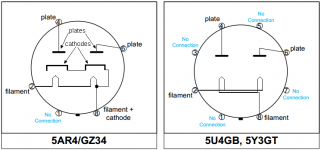
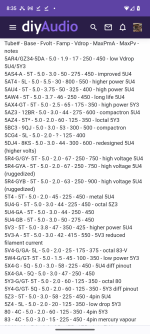
(I'm probably dumping redundant info so sorry in advance.)
I Need
- Filament requirement of 5volts @ < 2 amp or less.
(Will a lower current requirement result in voltage rise?)
-8 pin octal base
- indirectly heated variety with the filiment wire bridged to the cathode.
(What else do you call it? Lol )
-120 hopefully 150ma milliamp output.
(what's a typical overshoot for a safety margin?)
- Id like to have a vdrop of less than 50, but not at 25 watt resistor 5ar4 level.
Then cross reference that with price range and
add bottle shapes to mix.....
Does Anyone have an app for that?
( Ha ha it's called Google)
To me, spending a little bit to lower the b+ rise time is Worth it in the long run.
(Lotsa people have differing opinions, but I'd prefer to be gentle on something that hopefully lasts for years)
the 5y3gta is confusing me. The diagram looks like it's indirectly heated with a separate cathode.

Vs indirectly heated With a bridged cathode/filament like the 5ar4


Last edited:
Holy crap. it's quite a controversy as to what pin is appropriate for b+ tie in.

https://www.antiqueradios.com/forums/viewtopic.php?p=2764167

https://www.antiqueradios.com/forums/viewtopic.php?p=2764167
(I don't know at what current this is)
5z4 - vdrop 20
5v4g vdrop 25
5ar4. Vdrop 10-17
Gz34 vdrop
Edit- my earlier post was about a mercury rectifier.
5z4 - vdrop 20
5v4g vdrop 25
5ar4. Vdrop 10-17
Gz34 vdrop
Edit- my earlier post was about a mercury rectifier.
You're seriously overthinking this.I need to place all this info in one spot. Cycling between tabs to compare different specifications doesn't work for me.
(I'm probably dumping redundant info so sorry in advance.)
I Need
- Filament requirement of 5volts @ < 2 amp or less.
(Will a lower current requirement result in voltage rise?)
-8 pin octal base
- indirectly heated variety with the filiment wire bridged to the cathode.
(What else do you call it? Lol )
-120 hopefully 150ma milliamp output.
(what's a typical overshoot for a safety margin?)
- Id like to have a vdrop of less than 50, but not at 25 watt resistor 5ar4 level.
Then cross reference that with price range and
add bottle shapes to mix.....
Does Anyone have an app for that?
( Ha ha it's called Google)
To me, spending a little bit to lower the b+ rise time is Worth it in the long run.
(Lotsa people have differing opinions, but I'd prefer to be gentle on something that hopefully lasts for years)
the 5y3gta is confusing me. The diagram looks like it's indirectly heated with a separate cathode.
If you want a slow startup just use a 6087 / 5Y3WGTB. It's the right heater voltage and current for your PT since that's what it used originally. And it can supply the current drawn by the amp without being stressed. That's all you need to concern yourself with.
I like to use indirectly heated rectifiers too. In theory a slower startup makes sense and is desirable but there is absolutely no evidence that it makes a difference in practice. Many vintage amps used directly heated rectifiers and no problems resulted. If you've got a regular 5Y3 don't hesitate to use it while you're waiting for a 6087 to arrive.
The discussion you linked deals with a different rectifier which has a center tapped heater. The 5Y3 heater is not center tapped. The PS typically connects to Pin 8 but you can also use Pin 2. There is no difference electrically.
It makes no difference whether the heater and cathode are connected unless you're planning on running other tubes on the same heater winding. From a practical standpoint that really only applies to 6.3v tubes as there are very few 5v tubes other than rectifiers. I'm not even sure if there are any 5v rectifiers where the two are not connected.
The voltage drops shown in rectifier data sheets assume that the tube is being run at its maximum current and voltage and will vary a bit at lower current. The 5Y3 is rated for 125mA and the amp draws ~100mA so the drop will be close. Running a tube like the 5AR4, which is rated for 250mA means that the voltage drop will be even lower than the data sheet says if it's only supplying 100mA. Another reason not to use a 5AR4 in this situation. The 5Y3 is better suited to the circuit.
Run PSUD with a 5Y3 and the measured specs of your PT and adjust as necessary. Note the maximum value of the first cap is listed as 20uf. The modern value is 22uf. Since you're not running the tube at max you can probably go up to 33uf safely. Again, getting exactly the same B+ voltage as the schematic is not important, anywhere close is fine.
i just got off work and i'm playing around in psud2 with the new values. (im probably going with the 5y3wgta like you suggested) I am overthinking it, honestly i just like the thought of experimenting a little. This amp will be all that i can build for the foreseeable future. My place is small and anything beyond a 5 - 10 watts just swamps the room. Any advantage, even if its insignificant id like to try. (within budget and reason)
While you're experimenting in PSUD2 you might explore making the first cap in the power supply filtering chain smaller to reduce DC voltages, and larger capacitors after the choke to keep ripple down to your design goal. This strategy has several other benefits, approaching a choke input supply. Also, being a lower value, it's easier to use a larger physical size better quality cap at the input, maybe a motor run, for long life reliability.
An ideal power supply has the minimum of series resistors, and just the right value of first cap. Then, as big chokes and following caps as practical, up to the output amplifier take-off. (After that, you need series resistors for subsonic stability).
All good fortune,
Chris
An ideal power supply has the minimum of series resistors, and just the right value of first cap. Then, as big chokes and following caps as practical, up to the output amplifier take-off. (After that, you need series resistors for subsonic stability).
All good fortune,
Chris
You may know what V1 and V2 mean, but readers may not intuit it. Always best to be clear to everyone.
I'm suggesting an approach where you choose C1 for your desired output DC voltage, and then make enough filtering to reach your design goal of ripple. Or just add a second choke, which solves almost all ripple issues without sturm und drang.
All good fortune,
Chris
I'm suggesting an approach where you choose C1 for your desired output DC voltage, and then make enough filtering to reach your design goal of ripple. Or just add a second choke, which solves almost all ripple issues without sturm und drang.
All good fortune,
Chris
Is that 0.06 seconds? That's not even an eye-blink. The amplifier surely takes over a second to come to nominal bias, and many seconds to its long-term bias. What happens in the first 0.06 seconds at start-up is not interesting in music systems, and not too worrisome even for push-to-talk communications.Im worried about the scattered lines during startup
I had to find a replacement headphone jack due to me not knowing the difference between 1/4 and 3.5mm lol.
Anyway I was looking for an isolated jack because my ground is tied into the chassis at the input RCA jacks. After a week of searching I came up with this switchcraft.
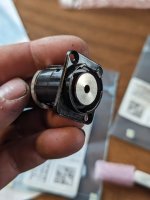
Its huge and very solidly built. The soldering terminals are large and it's internals are in plastic with a metal body
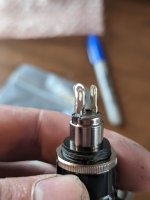
Anyway I was looking for an isolated jack because my ground is tied into the chassis at the input RCA jacks. After a week of searching I came up with this switchcraft.

Its huge and very solidly built. The soldering terminals are large and it's internals are in plastic with a metal body

- Home
- Amplifiers
- Tubes / Valves
- 2nd try single ended
